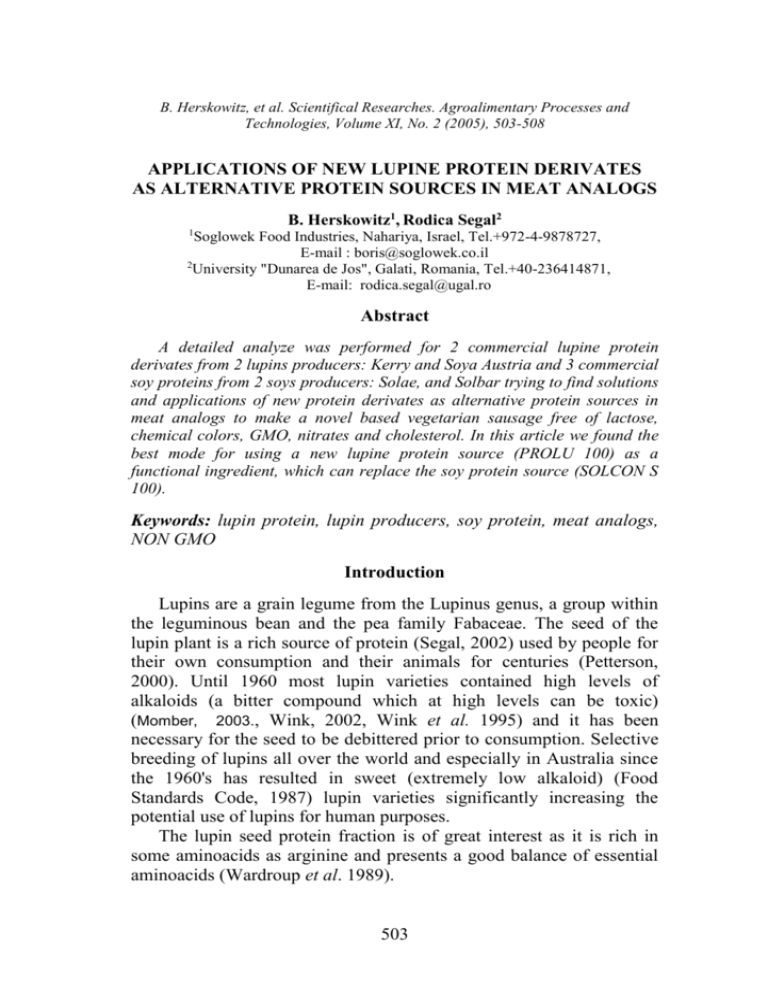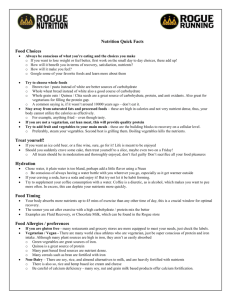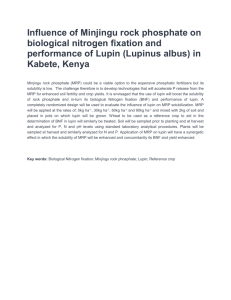applications of new lupine protein derivates
advertisement

B. Herskowitz, et al. Scientifical Researches. Agroalimentary Processes and Technologies, Volume XI, No. 2 (2005), 503-508 APPLICATIONS OF NEW LUPINE PROTEIN DERIVATES AS ALTERNATIVE PROTEIN SOURCES IN MEAT ANALOGS B. Herskowitz1, Rodica Segal2 1 Soglowek Food Industries, Nahariya, Israel, Tel.+972-4-9878727, E-mail : boris@soglowek.co.il 2 University "Dunarea de Jos", Galati, Romania, Tel.+40-236414871, E-mail: rodica.segal@ugal.ro Abstract A detailed analyze was performed for 2 commercial lupine protein derivates from 2 lupins producers: Kerry and Soya Austria and 3 commercial soy proteins from 2 soys producers: Solae, and Solbar trying to find solutions and applications of new protein derivates as alternative protein sources in meat analogs to make a novel based vegetarian sausage free of lactose, chemical colors, GMO, nitrates and cholesterol. In this article we found the best mode for using a new lupine protein source (PROLU 100) as a functional ingredient, which can replace the soy protein source (SOLCON S 100). Keywords: lupin protein, lupin producers, soy protein, meat analogs, NON GMO Introduction Lupins are a grain legume from the Lupinus genus, a group within the leguminous bean and the pea family Fabaceae. The seed of the lupin plant is a rich source of protein (Segal, 2002) used by people for their own consumption and their animals for centuries (Petterson, 2000). Until 1960 most lupin varieties contained high levels of alkaloids (a bitter compound which at high levels can be toxic) (Momber, 2003., Wink, 2002, Wink et al. 1995) and it has been necessary for the seed to be debittered prior to consumption. Selective breeding of lupins all over the world and especially in Australia since the 1960's has resulted in sweet (extremely low alkaloid) (Food Standards Code, 1987) lupin varieties significantly increasing the potential use of lupins for human purposes. The lupin seed protein fraction is of great interest as it is rich in some aminoacids as arginine and presents a good balance of essential aminoacids (Wardroup et al. 1989). 503 Applications of New Lupine Protein Derivates as Alternative Protein Sources in Meat Analogs Lupine has an advantage in its natural yellow color due to high levels of beta-carotene and total carotene, and its sweet flavor. These compounds lend to Lupine proteins their relative oxidative stability as well as healthy image. Soy protein concentrate (SPC) and isolated (ISP) are well known as functional and nutritional ingredients in the food industries (Stancu et al. 1975). Beside a high level of protein, both SPC and ISP contain other nutritional compounds such as soyisoflavones, soy-saponins etc. that related to prevention and treatment of chronically disease (Messina et al.1994). Based on these advantages, we have studied the use of lupin and soy proteins as functional and nutritional ingredients in novel vegetarian products. Experimental A pre-selection stage for commercial protein products was performed by determining the chemical (moisture, protein, protein solubility, ash, fat) and functional (gel strength, emulsion strength, powder color) properties of two Lupine Protein products (PROLU 100, Kerry Ingredients; LUPISAN, Soya Austria), two Functional Soy Protein Concentrates (SOLCON S100), Solbar Hatzor Ltd.; DANPRO 760S, Solae) and one Isolated Soy Protein (ISP) (SUPRO 620, Solea). PROLU 100, and SOLCON S 100 were then selected and used individually in 3 recipes for novel based vegetarian sausage formulas. Weight loss, chemical analysis, texture, sensory analysis was then analyzed in order to study the contribution of each protein product on the final sausage. Chemical analysis: Moisture: moisture analysis preformed by using an HR73, Halogen Moisture Analyzer based on the AOCS method No. Bc2-49. Protein: Protein content was detected using a KJELTEC 2030 instrument based on AOCS method No. Ba4b-87. Protein Solubility (NSI): The protein solubility of the powders was analyzed by determine the Nitrogen Solubility Index (NSI) based on AOCS method No. Ba11-65. Ash: The ash content was determined by drying the powders at 600ºC, cooling and calculating the ash as the residual mass, based on AOCS method No. Bc5-49. Fat: The fat percentages were measured by petrol-ether extraction using a 2050 Soxtec Avanti Automatic System based on AOCS method No. Bc3-49. 504 B. Herskowitz, et al. Scientifical Researches. Agroalimentary Processes and Technologies, Volume XI, No. 2 (2005), 503-508 Functional analysis: Gel Strength: A 20% protein solution was prepared using a Braun CombiMax 650 mixer. The final slurry was stuffed in two 50 ml plastic centrifugal tubes by spinning at 3000 . g for 5 min in a laboratory centrifuge type ALC PK121. After 30 min. chilling at 4ºC the tubes were cooked for 30 min. at 80ºC and chilled over-night at 4ºC. Thereafter a 30mm slice was cut and analyzed in a Texture-Analyzer (SMS) connected to a “0.5 inch diameter Derlin” cylinder probe. Emulsion Strength: A water:oil:protein emulsion in a ratio of 5:4:1 (respectively) was made and used in the same manner as the Gel Strength method. Powder Color: The powders color (L, a, b) was measured using a Minolta instrument direct on the powder and reading the values corresponding to each sample. Vegetarian sausage manufacture: A basic formula containing 1020% protein, 70% ice water, 2-5% natural stabilizers and spices, and 7-10 % oil was made in order to evaluate the differences of the protein sources. The ingredients were mixed in a laboratory Stefan mixer type for about 3 min. at 3000 rpm. The total mass was stuffed into cellulose casings and cooked for 30 min at 80ºC. After cooking the sausages were chilled over-night at 4ºC and then analyzed for chemical, sensorial and functional properties. Experiments: Based on the pre-selection stages we made 3 trails (numbered 1, 2, 3), which were produced in three replications of a vegetarian sausage using the basic formulations described. In the first group we used PROLU 100 + EGG WHITE, in the second group we used only PROLU 100 and in the third group we used only SOLCON S100 (Table 1). Table1. Lupine and soy proteins involved in the trails NR OF TRAILS 1 EGG WHITE X 2 SOLCON S100 PROLU 100 3 X X X Final products sensorial evaluations: Texture evaluation, juiciness, elasticity, taste, color and aroma were analyzed by point methods from 1 to 6 by 10 persons: 505 Applications of New Lupine Protein Derivates as Alternative Protein Sources in Meat Analogs 1 – for high quality 3 - 4 – for medium quality 6 – for low quality. Results and Discussions Chemical and functional analysis of the proteins: Analyzing the table 2 we pointed 4 parameters for our selection: NSI, gel strength, emulsion strength and fat. The first 3 parameters are lower for samples 5 and 8 compared to samples 1 and 2. The fat content of sample 5 has the biggest amount compared to all other samples. For continuing our trails we took only 2 proteins (1, 2) for the final products making products as described. Functional and sensorial properties of the final products: As the results present (fig.1) we can conclude that egg white binds better the water in the product but in the same time it gives a less juicy product. In the same time we can see that PROLU 100 – the lupine concentrate keeps better the water than the soy concentrate SOLCON S100 in the cooking and storage time. Table 2. Chemical and functional analyses of the proteins 3 2 SAMPLE NR. Product PROLU SOLCON name 100 S100 Company Moisture (%) Protein (d.s.) (%) Ash (%) NSI (%) Fat (%) Powder Color: L A b Gel Strength (gr.) Emulsion Strength (gr.) KERRY SOLBAR 7.5 52.61 2.72 74.41 0.29 8.41 68.13 7.53 73.14 0.73 86.38 -4.12 32.9 109.5 75 85.84 -0.67 14.38 234.2 200 1 5 SUPRO LUPISAN 620 SOYA SOLAE AUSTRIA 7.63 6.0 46.32 91 4.07 4.3 21.6 85 6.77 0.6 83.42 -1.06 35.78 No Gel 9 86.4 -0.5 15 500 250 8 DANPRO 760S SOLAE 6.02 67.07 6.47 46.68 0.66 87.12 -0.39 15.66 149.4 119.2 Fig. 2 is a result of texture analyzer for a distance of 12 mm. with registration in 70 points for each product. 506 B. Herskowitz, et al. Scientifical Researches. Agroalimentary Processes and Technologies, Volume XI, No. 2 (2005), 503-508 Although PROLU 100 + EGG WHITE gave the firmest texture (fig.2) its uniformity, color, and flavor were poor compared with both SOLCON S and PROLU 100. PROLU 100 has an advantage in its natural yellow color [due to high levels of beta-carotene (0.5 mg/100gr.), and total carotene (3 mg/100gr.)], its anti-oxidative capacity and its sweet flavor [which contributed to the final product flavor based vegetarian sausage, and its medium firmness (1000 gr.)] giving a tasty and juicy product. 3.50% 3.00% 2.50% 2.00% 1.50% 1.00% 0.50% 0.00% cooking loss storage loss cups storage loss cups 2w 4w storage loss sausages 2w storage loss sausages 4w total loss PROLU 100 + EGG W HITE 0.60% 0.85% 0.85% 1.00% 1.35% 1.95% PROLU 100 1.20% 0.97% 0.97% 1.85% 2.02% 3.21% SOLCON S100 1.31% 1.13% 1.13% 1.88% 2.02% 3.33% Fig. 1. Weight loss of vegetarian meat analogs 2500 Force (g) 2000 1500 1000 500 0 Distance (mm) PROLU 100 + E.W. PROLU 100 SOLCON S100 Fig. 2. Textural analyses for vegetarian meat sausages The evaluations were made in 3 replications and the average results were inscribed (p<0.05). The best results for the vegetarian meat analogs products were obtained for the vegetarian frankfurters with lupine concentrate PROLU 100: juiciness = 2.6; elasticity = 2.6; taste = 2.5; aroma = 2.4 (figure 3). 507 Applications of New Lupine Protein Derivates as Alternative Protein Sources in Meat Analogs PROLU 100+ALB PROLU 100 Elasticitatea SOLCON S100 PROBA 4 Textura 6.00 4.00 2.00 0.00 Suculenţa Aroma Culoare Gust PROBA 5 Fig. 3. Sensorial analyses of final products Conclusions We conclude by defining the best mode for using a new protein as an alternative source in meat analogs and as a functional ingredient is PROLU 100 a lupine protein concentrate. This protein has a functional and marketing advantage upon chemical and synthetic ingredients when it is used in "clean-labeled" (free of lactose, chemical colors, GMO, nitrates, cholesterol, etc.) healthy products, due to its natural high protein levels, texture, color, and flavor properties. References FOOD STANDARDS CODE, (1987). Australia New Zeeland Food Autority, Canberra. URL:http://www.anzfa.gov.au/ Messina, M. Messina, V. and Setchell, K. (1994). The simple soybean and your health, pp 50-100. Momber, R. (2003). Renwick Momber Farmers Pty. Ltd. E-mail: momber@iinet.net.au Petterson, D.S. (2000). The Use of Lupins in Feeding System. Asian–Aus. J. Anim. Sci. Vol. 13, No. 6: 861-882. Segal, R. (2002). Principiile nutriţiei. Editura Academica , Galaţi, pp. 50-66. Stancu, M. şi Segal, B. (1975). Surse noi de proteine. Editura tehnică, Bucureşti, pag.11- 55. Wardroup, P.W. and Smith, K.J. (1989). Animal feed uses of legumes. In: , R.H. Mattews (Editor), Legumes Chemistry, Technology and Human Nutrition. Marcel Dekker, Inc., pp. 245-337. Wink, M. (Hrsg.) (2002). Lupinen 2001- Ergebnisse aus forschung, Anbau und Verwertung, pp.12-28. Wink, M., Messner, C., Witte, L. (1995). Patterns of quinolizidine alkaloids in 56 species of the genus Lupinus. Phytochemistry 38, 139-153. 508

![Chiefly Sentimental [Doc]](http://s3.studylib.net/store/data/006648926_1-7a04bc5bf8639748b20cf9b3579105be-300x300.png)






